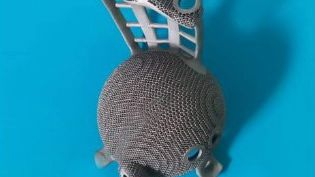Laboratory of Biomedical Engineering “Osteonika"
Today this technology is very relevant due to the enormous number of gunshot joint traumas. Today, we are selecting patients for this method of treatment. This type of injury is not subject to urgent surgical treatment; we need several weeks or months to conquer infections typical for all gunshot traumas.
Published: 15.10.2022
Laboratory of Biomedical Engineering “Osteonika" is the first laboratory in Ukraine focused on the design of individual orthopaedic implants
The laboratory was born in Kyiv in 2018. The laboratory's bioengineers and physicians are the followers of a personalized approach in medicine.Their customized implants have already found an active application in orthopaedics and trauma care, cancer orthopaedics, maxillofacial and neurosurgery.

How long does 3D printing exist in medicine, and what advantages does this technology have?
3D printing or additive technologies have been existing since 90th of the previous century. In 2000th, orthopaedic surgeons in other countries obtained access to 3D-printed implants. Thanks to laser sintering technology, a titanium printer makes it possible to get a biocompatible implant of almost any geometric shape accurately corresponding to a patient's specific anatomy. Exciting is the possibility of printing a trabecular (porous) surface to facilitate bone ingrowth.

The trabecular surface of a hip prosthetic component. The quality achievable only for the 3D printing technology
What is the purpose of 3D-printed prostheses?
They enable us to solve the most complicated problems with bone and joint defects. These defects may have different backgrounds: infection, injuries, oncology (bone tumours). We have no better option. Without this technology, a patient can't return to a full-scale life, becomes invalid. This unique technology makes unique operations possible. For instance, after a tumour's excision, Haluzynskyi O.A. et al. were the first in Ukraine to replace almost half of a pelvic with a customized titanium implant in one case and literally a whole femoral bone – in another one, making it possible to avoid amputations.

Fitting a customized pelvic implant on a full-size printed plastic mock-up prototype
Today this technology is very relevant due to the enormous number of gunshot joint traumas. Today, we are selecting patients for this method of treatment. This type of injury is not subject to urgent surgical treatment; we need several weeks or months to conquer infections typical for all gunshot traumas.
Manufacturing of a customized endoprosthesis -what does it look like, and how long does it takes?
First, we need an injured bone’s computed tomogram. Using special software, we develop its 3D model in an STL format. On the grounds of existing bone defects, a bioengineer designs an implant fixable reliably to the bone that will later grow through it. First, we print the prototype of a customized implant from plastic. Having adjusted the design with a responsible surgeon, we carry out titanium 3D printing. Fortunately, several Ukrainian companies do already have the necessary equipment. The whole process takes 2-3 weeks.

A gunshot lesion of a bone in a left hip area; a digitally designed implant
What about financing for customized implants for injured warriors of Ukraine?
Nowadays, we negotiate financial support for such surgical interventions with domestic and foreign foundations. We are also trying to encourage state officers from different levels to create a relevant budget-funded program, but the question is still far from a solution.
Founders of the Laboratory:

Haluzynskyi Oleksandr Anatoliiovych – PhD, orthopaedic and trauma surgeon, oncologist; over 20 years the surgical experience, and over 10 of them specialized in arthroplasties (replacements of joints). One of the first domestic surgeons to apply customized 3D-printed implants.

Burburska Svitlana Valeriivna – a bioengineer, an expert in additive technologies for medicine, post-graduate student of the mechanical engineering department at the NTUU “Ihor Sikorsky Kyiv Polytechnical Institute”. Main focus: designing customized implants and navigation systems.